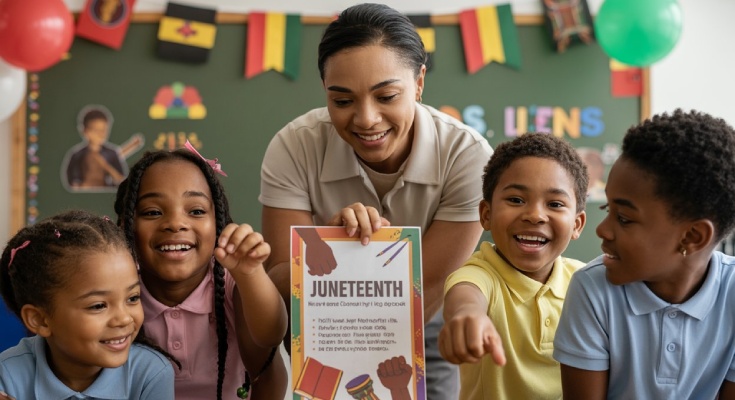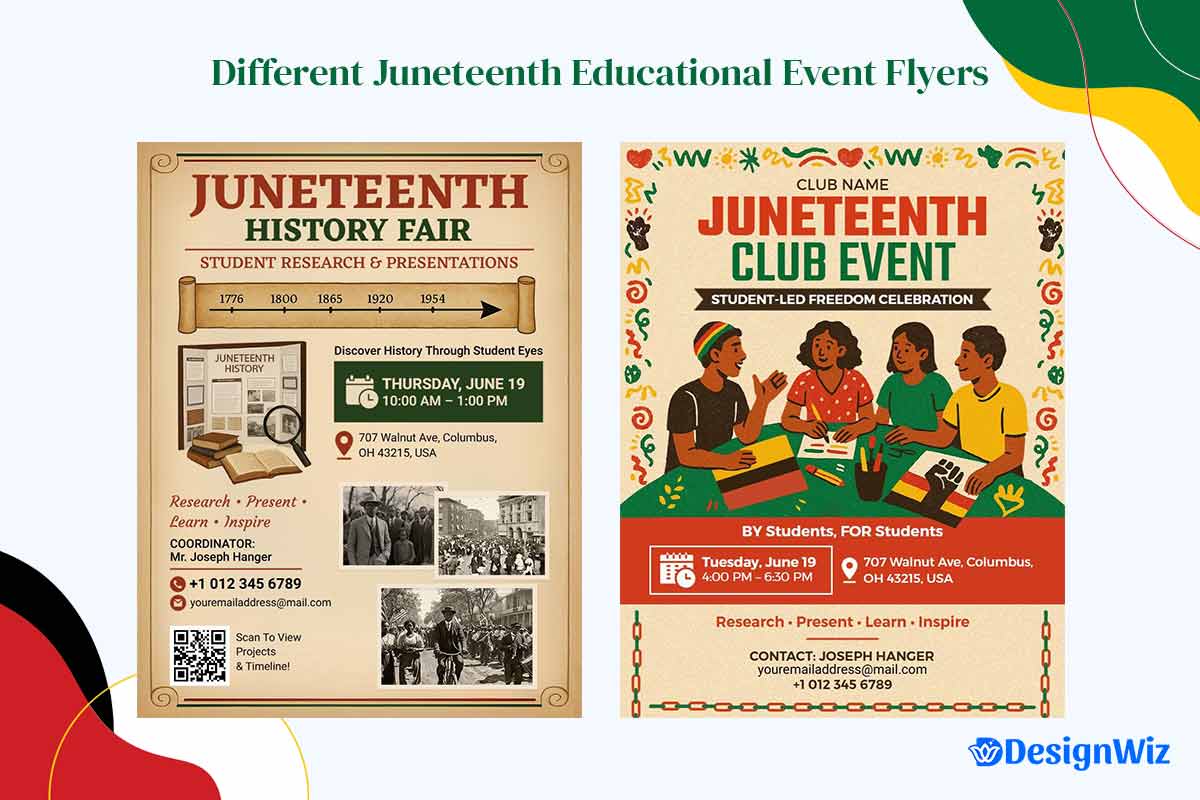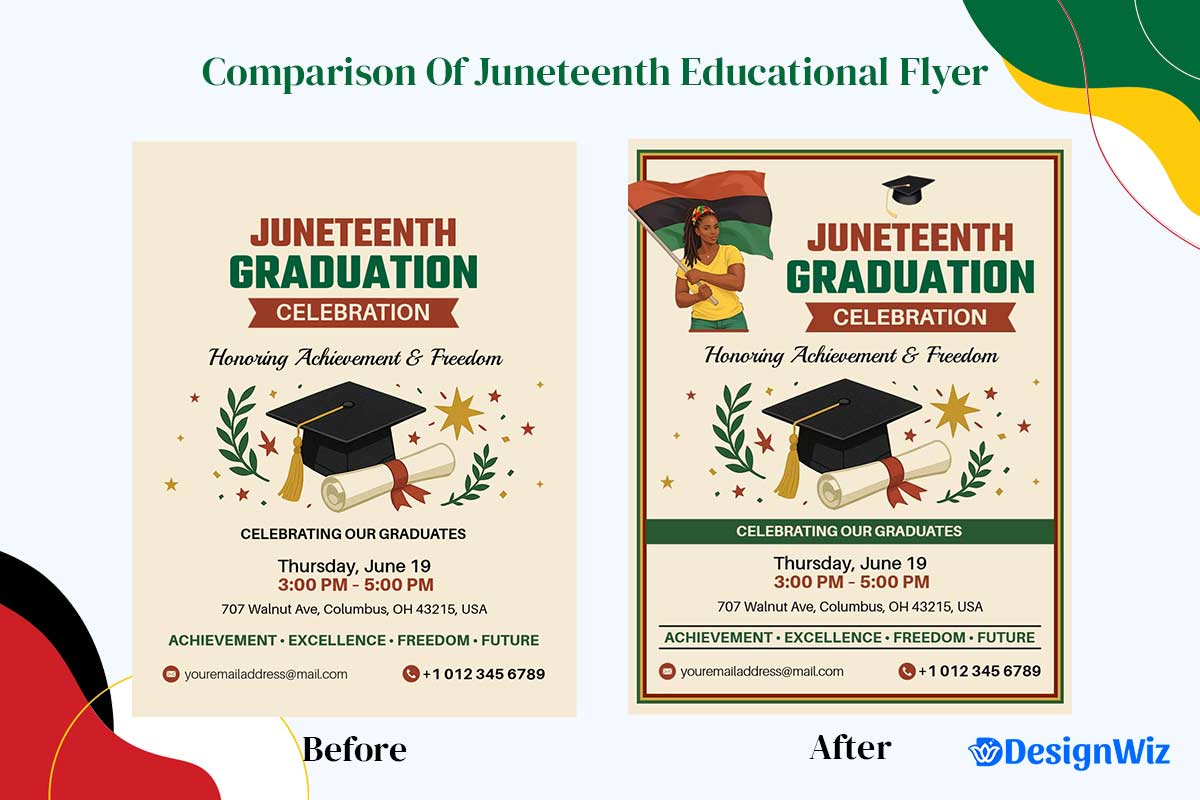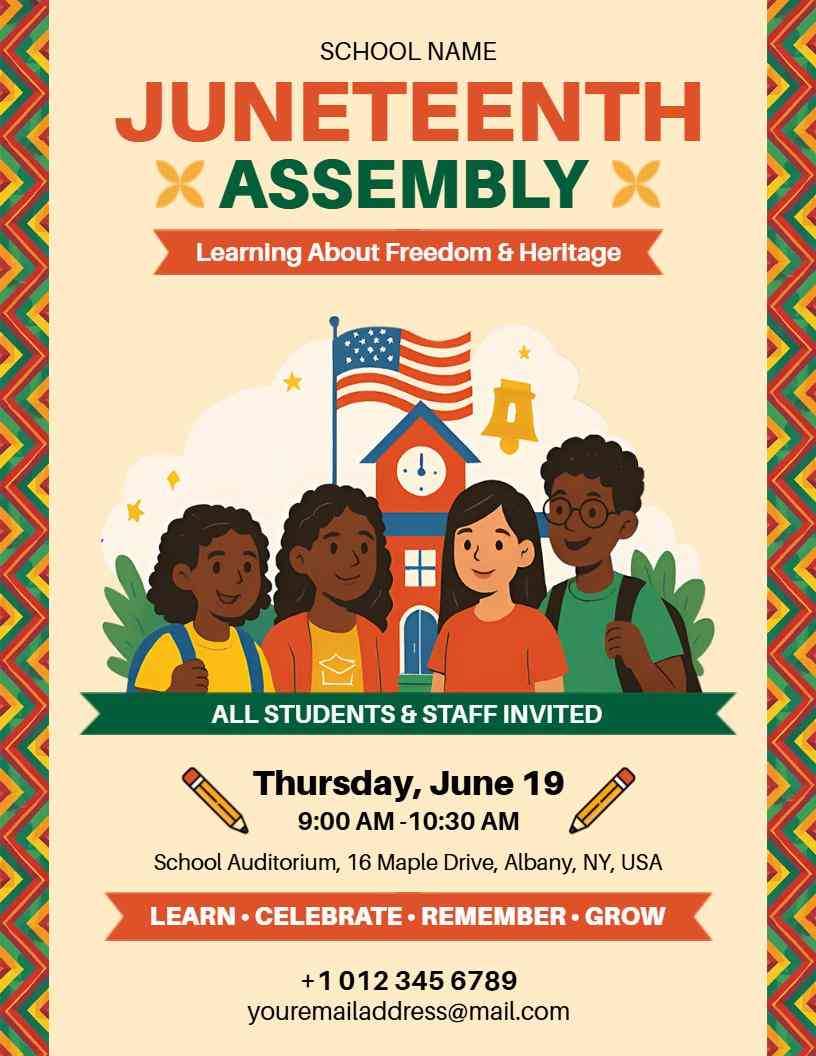Get ready-made flyer templates that educate and engage—thoughtful, vibrant, and designed for school and educational events.

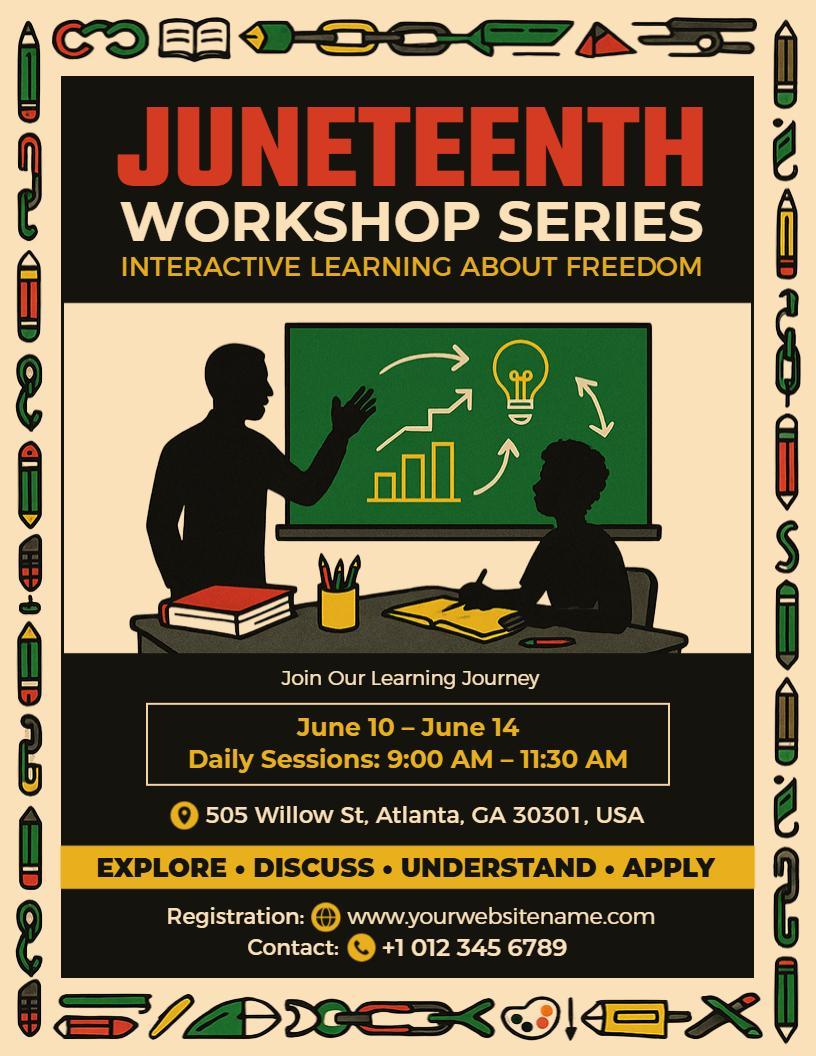
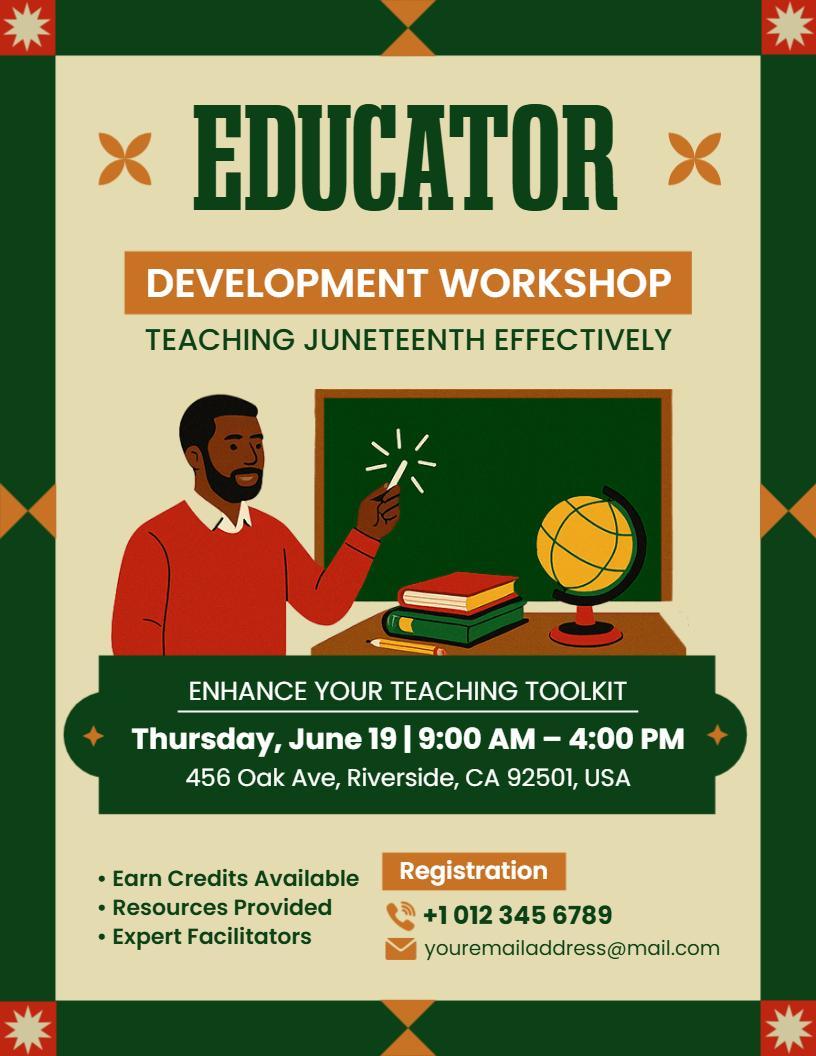

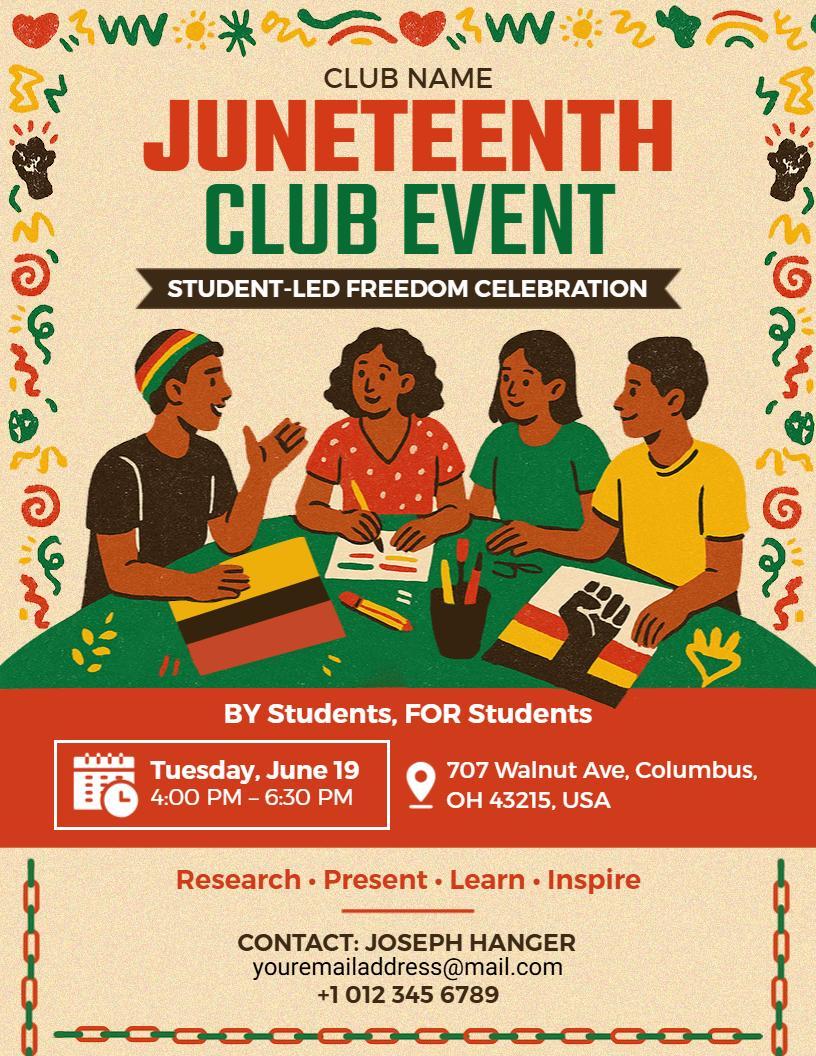
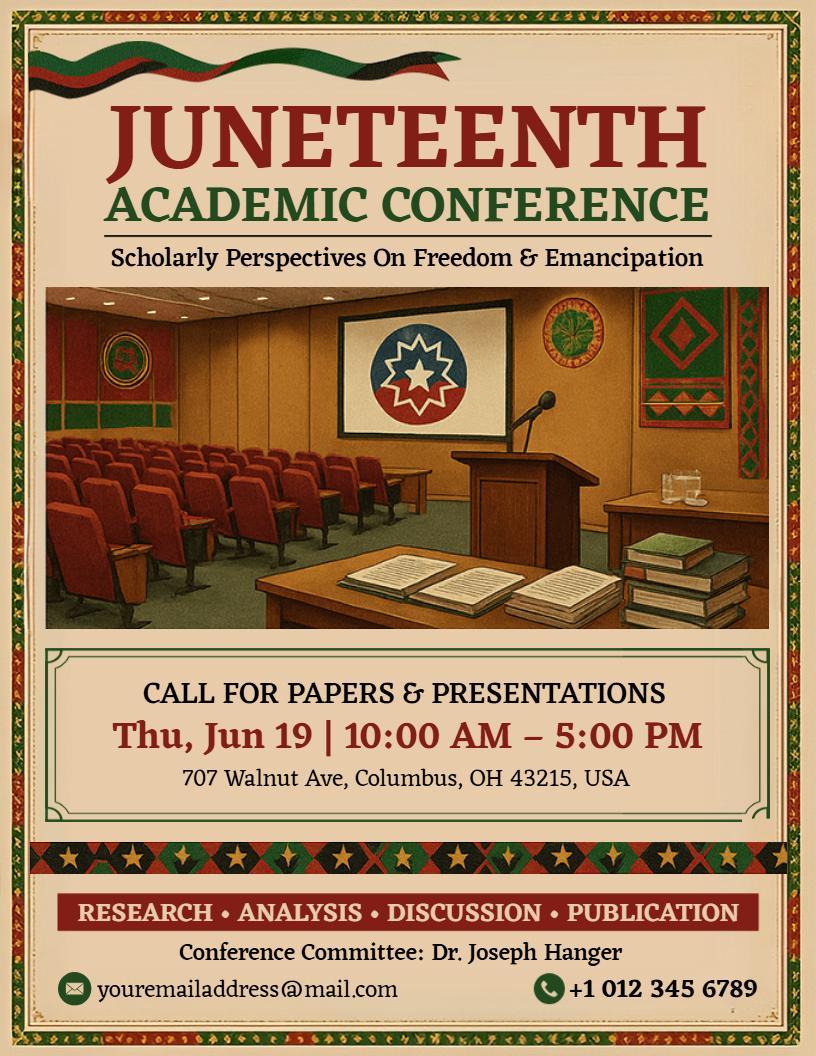
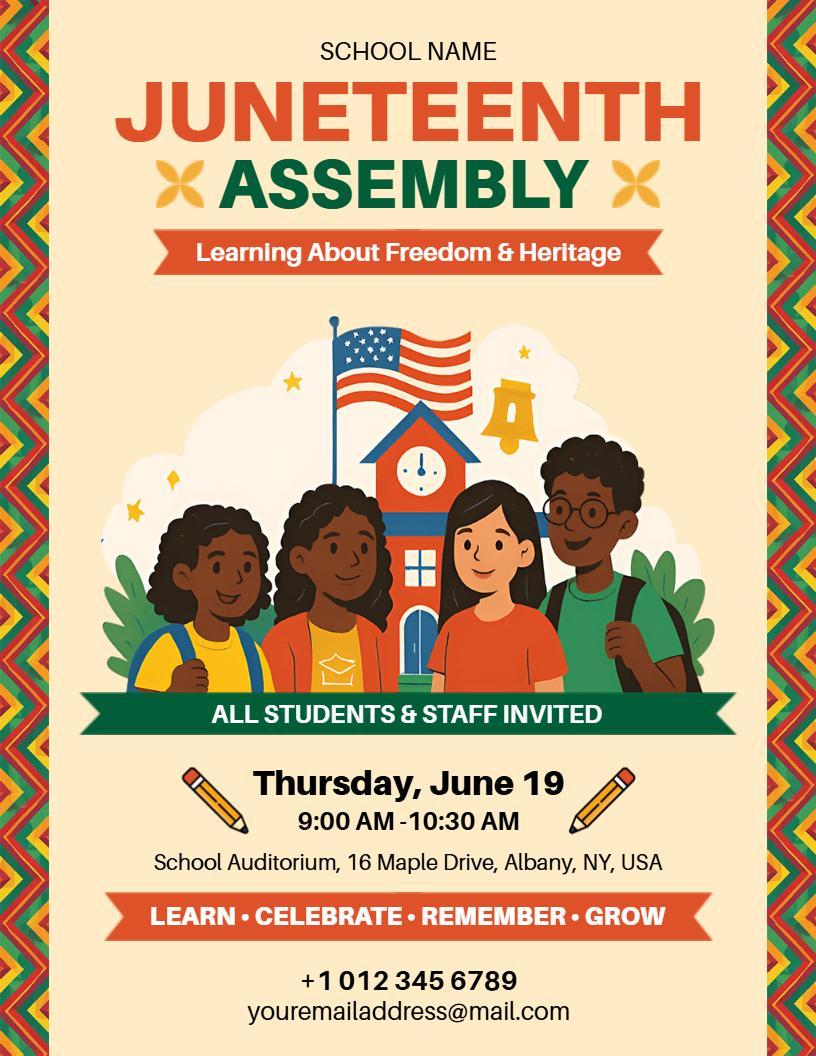

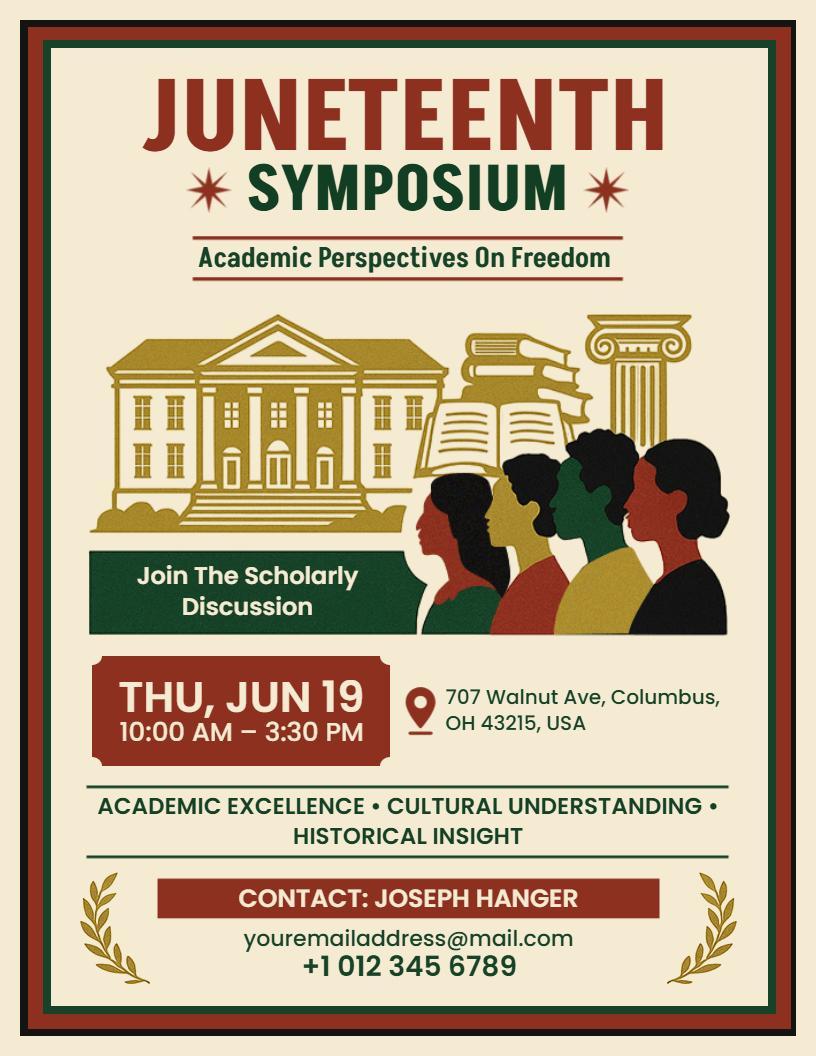
As Juneteenth 2025 approaches, educators across the country are preparing to engage students with age-appropriate celebrations that honor this significant holiday’s historical importance. Schools, libraries, museums, and educational organizations play a crucial role in ensuring young people understand Juneteenth’s meaning while participating in meaningful, celebratory learning experiences.
An effective Juneteenth School & Educational Flyers balance historical accuracy with age-appropriate presentation, incorporating educational objectives while clearly communicating event details to students, families, and the broader educational community. The unique educational dimensions of Juneteenth, themes of freedom, history, and civic engagement, provide rich material for meaningful learning experiences.
This comprehensive guide provides everything you need to create impactful, educationally sound flyers specifically for school-based and educational Juneteenth events, complementing our broader Juneteenth Flyer Design Guide for more tips and design inspiration. Whether you’re planning a school assembly, classroom activity, campus celebration, or community educational program, you’ll find pedagogically informed guidance for your specific educational context.
Throughout this guide, you’ll find references to our free Juneteenth Planning Checklist that includes a dedicated educational section with specialized planning tools for educators.
How Should Juneteenth Be Taught in Different Educational Settings?
Educational approaches to Juneteenth must be carefully calibrated to student developmental levels while maintaining historical accuracy and cultural sensitivity.
Age-Appropriate Approaches by Grade Level
Tailor your flyer content to different grade levels to ensure Juneteenth messages are meaningful and age-appropriate for all students.
Elementary School (K-5):
Focus on basic concepts of freedom, fairness, and celebration
- Emphasize the joy of freedom and the importance of celebrating
- Use age-appropriate language: “A special day when all people became free”
- Incorporate stories, songs, and visual elements
- Connect to concepts students understand: fairness, rules, and community
Middle School (6-8):
Introduce historical complexity and regional differences
- Discuss the timeline between the Emancipation Proclamation and Juneteenth
- Explore why news traveled slowly in 1865
- Connect to broader themes of communication, government, and justice
- Encourage critical thinking about historical events
High School (9-12):
Examine systemic issues and ongoing relevance
- Analyze the economic and political factors that delayed freedom
- Connect historical events to contemporary social justice movements
- Explore primary source documents and historical evidence
- Discuss ongoing implications and modern celebrations
According to Sonya Douglass, a professor of education leadership at Teachers College, Columbia University, and founding director of the Black Education Research Collective, Juneteenth should be taught year-round as part of a comprehensive Black studies curriculum spanning preK-12 education. She emphasizes that Juneteenth embodies the history from enslavement to emancipation, making it essential to integrate its lessons throughout the school year.1
Educational Settings and Their Unique Considerations
Each educational setting has distinct needs and priorities, so it’s important to tailor Juneteenth flyers to reflect their specific goals and audiences.
Public Schools:
Must align with state standards and maintain secular approach
- Focus on historical facts and civic significance
- Connect to existing history and social studies curricula
- Ensure inclusivity for all student populations
- Consider diverse family backgrounds and perspectives
Private and Charter Schools:
May have more curriculum flexibility
- Can incorporate broader themes of justice and equity
- May connect to school mission and values
- Consider school community demographics and values
Museums and Cultural Centers:
Focus on authentic historical presentation
- Emphasize primary sources and artifacts
- Provide deeper historical context
- Connect past to present experiences
- Offer family-friendly educational programming
- Fully editable & printable
- Age-appropriate styles: fun, respectful, educational
- Ideal for classroom activities, & student events
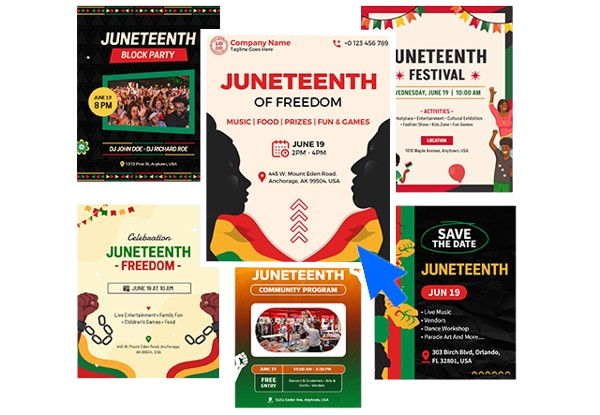
What Types of Educational Juneteenth Events Need Flyers?
Educational Juneteenth celebrations take various forms, each with unique promotional and design considerations:
School Assemblies and Presentations
Large-group educational events featuring guest speakers, performances, or multimedia presentations:
Design Considerations:
- Include presenter credentials and background
- Highlight educational objectives and takeaways
- Note any preparation students should do beforehand
- Specify grade levels the content is designed for
- Include time requirements and schedule details
Classroom Activities and Projects
Individual classroom or small-group learning experiences:
Design Considerations:
- Clearly indicate target grade level
- List materials students need to bring
- Include curriculum connections and learning standards
- Note any parent/guardian notification requirements
- Specify if this connects to larger school initiatives
Campus-Wide Celebrations
School-wide events that combine education with celebration:
Design Considerations:
- Include schedule of activities across the day
- Note different activities for different grade levels
- Highlight any special traditions or school-specific elements
- Include food service or lunch modifications if applicable
- Specify dress code or special attire if relevant
Educational Workshops and Seminars
Focused learning sessions for specific audiences:
Design Considerations:
- Clearly define target audience (students, educators, families)
- Include registration requirements and capacity limits
- Note any prerequisite knowledge or preparation
- Highlight continuing education credits if applicable
- Include resource lists or follow-up materials
What Essential Elements Should Educational Juneteenth Flyers Include?
Every Juneteenth School & Educational Flyers need these essential elements:
Core Educational Information
Ensure your flyer communicates key educational details clearly so schools, students, and parents know exactly what to expect from the Juneteenth event.
Event Name & Type:
- Clear identification as a Juneteenth educational event
- Specific indication of educational format (assembly, classroom activity, etc.)
- Institution or organization hosting
Academic Details:
- Target grade levels or age ranges
- Educational objectives and learning outcomes
- Curriculum connections and standards alignment
- Duration and time requirements
Practical Information:
- Date, time, and location details
- Registration requirements if applicable
- Materials students should bring
- Parent notification or permission requirements
Age-Appropriate Historical Elements
Design your flyer to present historical and cultural elements in a way that resonates with the age group you’re educating, ensuring both engagement and understanding.
Historical Context:
- Juneteenth significance explained for target age group
- Key dates and facts presented appropriately
- Connection to broader historical themes
- Visual timeline or historical graphics
Cultural Elements:
- Traditional colors and symbols explained
- Age-appropriate discussion of freedom themes
- Connection to contemporary celebrations
- Respectful cultural representation
According to Aisha White, For younger children, picture books can serve as an effective tool to introduce the concept of freedom and the significance of Juneteenth. As children grow older, more detailed discussions about the historical context and the struggles for liberation can be incorporated to deepen their understanding.2
Institutional Requirements
Ensure your flyer meets institutional expectations by including essential branding and administrative information to support clarity, safety, and accessibility.
School/Organization Branding:
- Institution logo and identifying information
- Alignment with school mission and values
- Contact information for questions
- Website or additional resource links
Administrative Details:
- Administrative approval indicators if required
- Safety protocols or special considerations
- Accessibility accommodations available
- Emergency contact information
How to Design Age-Appropriate Juneteenth Flyers?
Creating effective Juneteenth school flyers means understanding your audience and taking the time to design your own flyer with purpose and meaning.
Design Principles for Different Age Groups
Tailor your flyer design to engage each age group effectively by using appropriate colors, fonts, and visuals that match their developmental and interest levels.
Elementary School Design (K-5):
- Use bright, engaging colors with high contrast
- Include large, friendly fonts that early readers can process
- Incorporate cartoon-style illustrations or child-friendly graphics
- Use plenty of white space to avoid overwhelming young readers
- Include visual symbols and icons to support text
Middle School Design (6-8):
- Balance colorful elements with more sophisticated layouts
- Use fonts that appeal to tweens while maintaining readability
- Include historical photos alongside contemporary images
- Create visual hierarchy that guides reading flow
- Incorporate elements that feel mature but not overly serious
High School Design (9-12):
- Use more sophisticated color palettes and typography
- Include primary source document excerpts or historical quotes
- Balance historical gravitas with celebratory elements
- Create designs that teens would want to share on social media
- Use layouts that convey academic rigor
Template Selection for Educational Settings
- Choose templates with clear educational focus
- Look for designs that can accommodate curriculum connections
- Select layouts with space for learning objectives
- Consider templates with historical timeline elements
- Ensure designs work with institutional branding requirements
How to Incorporate Learning Objectives in Juneteenth Flyers?
Creating effective Juneteenth School & Educational Flyers requires understanding the visual and cognitive development of your target audience, and using Juneteenth flyer templates can help you get started quickly and confidently.
Curriculum Standards Integration
Integrate Juneteenth education across subjects by aligning with curriculum standards and encouraging cross-disciplinary learning.
Social Studies Standards:
- NCSS Thematic Standards (Time, Continuity, and Change; People, Places, and Environments)
- State-specific history and geography standards
- Civic ideals and practices connections
- Historical thinking and analysis skills
Cross-Curricular Connections:
- English Language Arts: Primary source analysis, narrative writing
- Mathematics: Timeline construction, data analysis of historical demographics
- Arts: Music history, visual arts, creative expression
- Science: Communication technology evolution, geography and migration patterns
Learning Outcome Examples by Grade Level
Outline clear, grade-specific learning outcomes to guide student understanding and engagement with Juneteenth.
Elementary (K-5):
- Students will identify Juneteenth as a celebration of freedom
- Students will sequence basic events leading to Juneteenth
- Students will express understanding through art, music, or writing
Middle School (6-8):
- Students will analyze primary source documents from the Reconstruction era
- Students will compare and contrast different experiences of emancipation
- Students will create multimedia presentations connecting past to present
High School (9-12):
- Students will evaluate the economic and political factors influencing emancipation
- Students will synthesize multiple historical perspectives on freedom and equality
- Students will develop arguments about the ongoing relevance of Juneteenth
Easily find age-appropriate Juneteenth content for students from kindergarten through high school. This tool provides tailored learning objectives, activities, and design ideas to help educators and parents create meaningful lessons for every grade level.
Find age-appropriate content, objectives, activities, and design guidance
Last-Minute Educational Juneteenth Planning Guide for 2025
As Juneteenth approaches, here are educator-focused strategies for quick implementation:
Quick Educational Solutions
- Use curriculum-aligned templates requiring minimal customization
- Focus on essential learning objectives rather than comprehensive coverage
- Leverage existing classroom resources and bulletin board displays
- Create simple handouts that can accompany existing lesson plans
Rapid School Distribution Strategy
For maximum educational reach in limited time:
Internal School Channels:
- Add to weekly faculty newsletters immediately
- Include in daily announcements for three weeks
- Share through grade-level team communications
- Post in teacher workrooms and common areas
Campus Communication Channels:
- Promote through student organization newsletters and bulletin boards
- Include in morning or weekly campus announcements
- Share via department heads and academic advisors
- Post on digital signage across common areas and student centers
Internal Academic Communication Channels:
- Include in department and faculty newsletters
- Share in academic calendar updates and faculty meetings
- Promote via graduate program bulletins and research group emails
- Post on office doors, faculty lounges, and departmental bulletin boards
Educational Juneteenth Flyer Design Inspiration Gallery
Here’s a curated selection of educational Juneteenth flyer designs to inspire your own creation. Each links to a full preview page with customization options:
- Juneteenth School Assembly Celebration Flyer
- Juneteenth Student History Fair Flyer
- Juneteenth Educational Workshop Series Flyer
- Juneteenth College Campus Event Flyer
- Juneteenth Educator Development Workshop Flyer
- Juneteenth Student Club Event Flyer
- Juneteenth Reading Celebration Event Flyer
- Juneteenth Art Exhibition Flyer Template
- Juneteenth Academic Conference Flyer
- Juneteenth Graduation Achievement Celebration Flyer
Expert Insights: Tips from Educators and Historians
We’ve gathered advice from experienced educators and historians who have successfully integrated Juneteenth into educational programming:
Start with Student Development
Dr. Patricia Williams, Elementary Education Specialist: “Always begin with what your students can developmentally understand, then build the historical content around that. For younger students, focus on the celebration and freedom themes. For older students, you can explore the complexity of delayed freedom and its implications.”
Connect to Existing Curriculum
Marcus Johnson, High School History Teacher: “The most effective Juneteenth programming I’ve seen builds on existing history and social studies curriculum rather than creating something completely separate. Connect it to your Reconstruction unit, your Civil Rights unit, or your study of primary sources.”
Balance Celebration with Education
Dr. Angela Rodriguez, Museum Education Director: “Students need to understand that Juneteenth is both a celebration and a learning opportunity. Your promotional materials should reflect this balance, showing both the joy of freedom and the serious historical significance of delayed liberation.”
Provide Family Resources
Jennifer Chen, School Community Liaison: “Include take-home components or family discussion guides in your programming. Many families want to continue these conversations at home but don’t know how to approach the topic appropriately with their children.”
Use Primary Sources Appropriately
Dr. Robert Jackson, Professor of African American History: “Primary sources are powerful teaching tools, but they must be carefully selected and contextualized for student audiences. A simplified version of General Order No. 3 can be very impactful for middle and high school students.”
FAQs About Educational Juneteenth Events
For elementary students, focus on age-appropriate concepts: 1) Explain that long ago, some people weren’t free and had to work without being paid, 2) Tell them about a special day (June 19, 1865) when everyone finally learned that all people were free, 3) Emphasize that this was a very happy day and why we celebrate it now, 4) Connect it to concepts they understand like fairness, rules, and treating everyone kindly, 5) Use simple language: “Juneteenth is a special day when we celebrate freedom and remember that all people should be free.” Focus on the celebration and positive themes while acknowledging the historical significance in simple terms.
Juneteenth education aligns with key curriculum standards across subjects. In Social Studies, it supports NCSS themes like Time, Continuity and Change; People, Places, and Environments; and Civic Ideals. In English Language Arts, it promotes reading comprehension, discussion, and primary source analysis. It also covers history standards on Reconstruction, the Civil War, and African American contributions. Check your state’s social studies framework for specific alignment.
Create inclusive Juneteenth education by: 1) Framing it as American history that affects everyone, not just African American students, 2) Connecting themes of freedom and justice to universal values, 3) Discussing how different communities have experienced and fought for freedom throughout history, 4) Including diverse perspectives and voices in your materials, 5) Avoiding assumptions about student background knowledge or family history, 6) Providing multiple ways for students to engage based on their interests and learning styles, 7) Creating classroom environments where all students feel safe to ask questions and share perspectives.
People Also Ask
What makes an effective Juneteenth educational flyer for schools?
Effective school flyers include clear grade-level specifications, learning objectives that connect to curriculum standards, logistical details (date, time, location, duration), any special requirements (permission slips, materials needed), educational credentials of presenters, and contact information for questions. Use professional design with historical imagery and ensure all text is easily readable by both students and parents.
Can Juneteenth educational events be held year-round or only in June?
While June is the traditional time for Juneteenth education, these programs can be effective year-round. Many schools integrate Juneteenth into Black History Month (February), Constitution Day lessons, or Civil War/Reconstruction units. The key is connecting Juneteenth to broader themes of freedom, citizenship, and American history that appear throughout standard curricula.
What resources are available for planning school Juneteenth assemblies?
Many organizations provide free Juneteenth educational resources including the Smithsonian’s National Museum of African American History, Teaching Tolerance, the Library of Congress, and local historical societies. These offer age-appropriate presentations, primary source documents, multimedia resources, and speaker recommendations. Many feature downloadable materials specifically designed for school assemblies and educational events.
Conclusion
Creating effective Juneteenth School & Educational Flyers requires balancing historical accuracy with age-appropriate presentation while clearly communicating learning objectives to students, families, and the broader educational community. By following the guidance and using our editable flyer templates, you’ll create flyers that not only promote educational events but also contribute to meaningful, academically sound learning experiences.
Remember these key principles for Juneteenth School & Educational Flyers:
- Match content complexity to student developmental levels
- Connect clearly to curriculum standards and learning objectives
- Balance celebratory elements with historical significance
- Provide resources for families to continue learning at home
- Jumpstart your Juneteenth 2025 preparations with these focused, actionable steps.
Reference
- “Juneteenth: How and Why It Should Be Taught in K-12 Schools.” Archived from the original on June 17, 2022. Retrieved June 3, 2025. Najarro, I.
- “How to Talk to Children About Juneteenth.” Archived from the original on June 19, 2020. Retrieved June 3, 2025. White, A.
